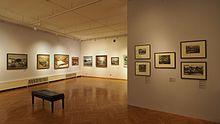Wikimedia Blog/Drafts/Virtual exhibition: a way to showcase the artworks in Wikipedia?
|
This page is currently a draft. More information pertaining to this may be available on the talk page. Translation admins: Normally, drafts should not be marked for translation. |
Title ideas[edit]
- Ideally three to ten words, the headline to your piece will show up in social media shares and on the blog's homepage. Try to capture the most interesting part of your piece.
- Virtual exhibition: a way to showcase the artworks in Wikipedia?
- ...
Summary[edit]
- A brief summary of the post's content, about 20-50 words. On the blog, the summary will appear in italicized text underneath the headline. You can use this space as a teaser, expansion of your headline, or as a summary of the post.
- Cooperation between Wikipedia and various museums gives rise to the new opportunities in making the public collections truly public. One way to achieve that is via online displays, like the first virtual art exhibition in the Estonian Wikipedia titled "The decisive years prior to Independence: Moments from the Estonian art of 1914–18". This is the story on how that came to be.
Body[edit]
- What do you want to tell the world? Put it here. The best imagery helps convey your most basic ideas without doing it overtly. Ideas on introductions and writing style can be found in our guidelines.

Estonian museums hold nearly 9 million items, but only 3.5% of it is being shown in exhibitions.[1] It isn't much different in other countries: museums do have a limited display space and can only open up a fraction of their collections to the general public at any given moment. Much of that, what is preserved, may even never leave from the temperature and humidity controlled darkened storage rooms, besides maybe visiting restoration department once and a while. That includes even many of the works by the best-known artists.[2]

One of the solutions could be putting the collection online and this is also what we are widely seeing all around the globe. But it would still take long until everything gets digitized and even after that, it isn't yet a norm, that museums are willing to sheer the original repros free to the world, not only limit it to downsized samples. But when we do get to the point, where images are no longer locked away just like the artworks and other items in the museums at a present moment, then we have another problem. How to organize this information and build context around it?
This is where Wikipedia might help. And not just this online encyclopedia, but all the Wikimedia ecosystem together with the community that keeps it running. So far we have often focused on just collecting the images and other media files. When museums are ready to provide some images, we happily bring them to Wikimedia Commons and link them with Wikidata and consider the mission accomplished. But with more and more museums and collections coming in, it will not be just harder to make the works seen, but to even do anything with the files after getting them uploaded.
With digitalization and with open sharing we are rapidly moving towards an era where much of the human culture becomes freely accessible to every human being. That allows us to step on the shoulders of our forerunners and reach even higher. But that also poses new challenges. Will we make sure, that this information is indeed made available for reuse so that we can actually build on it? And can we provide the ways around it so that it gets organized in a meaningful way and can be found by the people looking for it?

In Estonia in 2017 we started actively engaging museums and that soon got us started with several new cooperation projects. Among the first ones, there was Tartu Art Museum, that is the second biggest art museum in the country. So when we needed to come up with something for the Europeana 1914-1918 project, then it didn't seem too far-fetched to explore the World War I not directly, but via its possible influence to the Estonian art world.
The virtual tour compromises of three sections: an introductory text, image gallery, and guestbook. It contains 46 works from the collections of both Tartu Art Museum and Art Museum of Estonia. Besides Estonian, the information is also provided in English, Swedish and in Finnish. All of that was mainly assembled by Ivo Kruusamägi (wikipedian), Merli-Triin Eiskop (Tartu Art Museum) and Stina Sarapuu (Art Museum of Estonia). Buth also with help of many wikipedians.
As a conclusion, it might be said that online exhibitions are an easy way to show the content we have in Wikimedia, to build cooperation between Wikimedia and other organizations, and to organize our media files in a meaningful way, that itself is a huge challenge for Wikimedia Commons. But this a challenge is what we must think more of.
Ivo Kruusamägi, wikimedian from Estonia
References[edit]
- ↑ Reet Weidebaum: "Eesti ligi üheksast miljonist museaalist on näitusesaalides vaid 3,5 protsenti" ERR, 18 March 2018 (in Estonian)
- ↑ Christopher Groskopf: "Museums are keeping a ton of the world’s most famous art locked away in storage" Quartz, 20 January 2016
